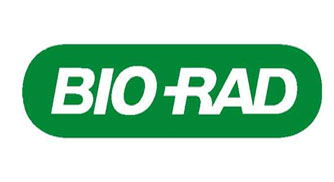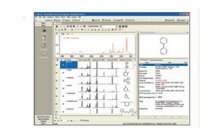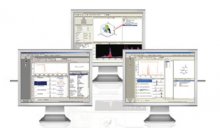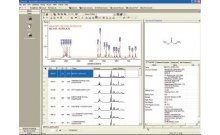重叠密度热图_在多谱图中可视化和评估相似性的新方法
会议Poster
Overlap Density Heatmaps: A Novel Method For Visualizing and Evaluating The (Dis)Similarity Among Multiple Spectra
Abstract
In this study, we introduce a novel tool, the Overlap Density Heatmap (ODH), for the visualization and quantitative evaluation of the (dis)similarity in massive amounts of spectral or chromatographic data. An ODH displays the common and unique features of over-lapped objects through color coding areas depicting levels of overlap. By changing the OD scale, one can choose to display only those features of a certain level of commonality (ODC) or uniqueness (ODU), and one can generate their respective consensus spectrum.
ODHs can be used in a wide variety of applications, and has particular relevance to the quantitative evaluation of metabolomics spectral data. As an example, in a study of the 1 H NMR spectra of human serum samples from 37 diabetic and non-diabetic subjects, we generated OD consensus spectra at ~80% ODC of the normal and diabetic samples, and obtained a difference spectrum of the two, at an off-set of 1.0. This difference spectrum identified diagnostic peak regions common to all diabetic or all normal patient samples. Using the difference spectrum as a search against the whole dataset revealed clear separation between both patient populations. Further, we then deployed the difference spectrum as a search query against a database of known metabolites. The hits retrieved contained metabolites with sugar moieties (largely monosaccharide and disaccharides), further supporting the versatility of applying the ODH technique to metabolite identification. In a separate metabolomics study, we deployed PCA technique to the analysis of the 37 biological samples.
Good class separation between both patient populations was obtained. The observed loadings plot, highlighting important diagnostic peak positions which may characterize certain implicated metabolites, was compared to the difference spectrum from ODH and found to share many similar features. When used as search queries, both spectra (loadings plot and ODH-based difference spectrum) retrieved metabolites that favor sugar-based moieties (vide infra). These findings demonstrate that ODH can provide an unbiased approach to enhancing the multivariate analysis and interpretation of NMR-based metabolomics data.
Conclusions
We have shown that our new and patent-pending Overlay Heat Density (ODH) technique has wide applications in spectral visualization, analysis, and optionally metabolomics research. In combination with chemometric technique, the ODH technology offers a very powerful approach to the study of metabolite identification and characterization. Incorporation of Infometrix's chemometric program (Pirouette ® ) into the KnowItAll platform offers a fully-integrated NMR-based metabolomics investigation to researchers. Such an integrated platform opens the door to multi-technique metabolomics study which should provide more options for researchers in this area.




